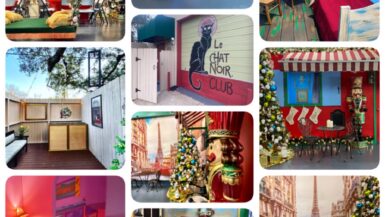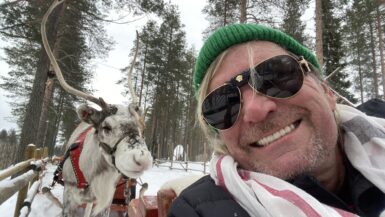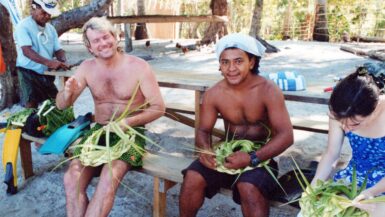If you were asked to describe the perfect Christmas scene in your mind, chances are you might conjure up images of roasting chestnuts,reindeer, snow, lighted Christmas trees and yule logs. If you live in Texas, you’re in for a disappointment. If that’s how you envision the holidays, you’re unlikely to see many of those things in the Lone Star State. These icons have been associated with Christmas through songs, poems, movies and advertisements and ingrained in our thoughts since childhood . You might ask yourself why each year we decorate a tree, give gifts, have yule logs, make gingerbread cookies and think about Santa Claus. Most of our traditions have come from Europe and there’s no better way to see Christmas than the source.
Near the end of November many European cities begin bringing in timber huts, evergreen trees, ice skating rinks, and portable shops as they create their own Christmas markets. This usually happens in the center of the historic part of town, often next to a cathedral or other famous landmark. Within a week or two, the area is transformed into a beautiful outdoor mall called a Christmas market. If you want to experience the smells, sounds, chills and tastes that you imagine from the perfect Christmas, visiting a few of these will do the trick. The tradition of the Christmas market, or Christkindelmarik as it was originally called (or Marche’ de Noel in France), began in Strasbourg in 1570. For this reason, Strasbourg is often referred to as the capital of Christmas.
The first Christmas trees appeared in Germany in the 16th century. Some historians believe that Martin Luther created the tradition of lighting candles on the tree while noticing all the stars in the sky one winter night. Fruits, nuts and gifts were added to the boughs of the trees. In the early 1800s England adopted the tradition and pretty soon everyone was doing it. Ask any Latvian or Estonian about the origin of the first decorated Christmas tree and they’ll claim they invented it. Regardless of who started it, you’ll see beautifully decorated trees throughout the markets with cute little shops that sell sausages, pretzels, mulled wine as well as seasonal gifts, custom made hats, and ornaments. You have heard about roasted chestnuts your entire life but have you ever eaten one? How are they? mehhh…. Grab a mug of gluhwein and take in the scenery. You won’t see anything like this in an American mall.
Santa Claus’s origins are an interesting hodge podge of European legends. The story begins with Nicholas, a Greek/Turkish man who’s parents raised him as a devout Christian but died at an early age and left him their fortune. Nicholas used all of his inheritance to help the needy and eventually became the Bishop of Myra. The name Santa Claus is a variation of the Dutch name Sinterklaas, which means St. Nicholas. That’s why there’s a St. Nick and a Santa Claus. It’s really the same name. Somehow St. Nick got mixed together with Odin, who would fly his white horses across the sky. In the US, the horses evolved into reindeer , Sinterklaas’ assistant Zwarte Piet was the inspiration for Santa’s elves. Mid-November Sinterklaas arrives on his boat from Spain and ride his white horse through the streets of Amsterdam. It’s a big event and everyone in the city turns out to see his grand entrance. He doesn’t look like the American Santa. He wears a red and white long costume with a papal hat, long beard and staff. He looks like a cross between the pope, Santa and Poseidon. His helpers pass out handfuls of little miniature cookies and marshmallows that bear a striking resemblance to Lucky Charms. If you can coordinate your visit to Europe with Sinterklaas’ arrival, you won’t be sorry.
If you prefer the more traditional Santa and reindeer, visit the North Pole. I’m not kidding. In Finland, right above the Arctic Circle is the official village of Santa Claus. The town is called Roveniemi and Santa is there 365 days a year with his reindeer. This little village has a toyshop, Christmas exhibition area, as well as photography opportunities with Father Christmas. Snowman World Ice bar is a bar and restaurant where everything is carved out of ice including the drinking glasses and you won’t find colder drinks anywhere. If you have dog sledding on your bucket list, it’s possible to set up a dog ride, take a reindeer sleigh for a spin or if you’re not satisfied with Donner and Blitzen’s performance, order a reindeer burger at the restaurant. Just don’t tell the kids.
Iceland has probably the least agreeable Christmas traditions. The Yule Lads are the Icelandic version of Santa Claus, and there are 13 of them. For the 13 nights leading too Christmas, one Yule Lad will pay your house a visit and leave presents in your shoes if you’ve been good, rotten potatoes if you haven’t. They’re fairly PC now, but in past legends historically they were described as pranksters who vandalized your home to monsters that ate bad kids. Now that’s what I call an Icelandic Merry Christmas! Iceland makes a great stop on your way to Europe since there’s usually a free stopover with Iceland Air and gives one a chance to see the Aurora Borealis and swim in the hot springs surrounded by snow. There’s also amazing glaciers and waterfalls within a few hours of the capital, Reykjavik.
For my money, the best way to experience a European Christmas is to visit the medieval cities in the south of Germany, almost any place in Austria and the eastern French towns near Alsace. One can literally follow the Rhine river from Strasbourg to Basel and you won’t find a town that’s not interesting and beautiful. These villages look like what you expect Christmas to look like. Look down at the town and you’ll feel like you’re looking at a 3D Christmas card. Arrive at the beginning of the season and you can watch the Europeans put out their wreaths on their doors and prepare the town for the holidays. Walk into a bakery and try the lebkuchen and stollen. Lebkuchen is similar to gingerbread and stollen is a buttery fruit-filled loaf coated with sugar. Try the delicious sausages and beer that’s unique to each city. Put an “er” on the name of the town and that’s what each area call it’s sausages. Nuremberg has Nurembergers, Heidelberg has Heidelbergers and Hamburg has… (yes, you guessed it! Hamburgers) Hamburgers are actually sausages. Just to be be fair, Frankfurters are sausages too. Weiner Schnitzels have no Weiners in them at all. Berliners are doughnuts. Confused? You’ll figure it out once you get there.






Leave a reply
You must be logged in to post a comment.